People
Legendary Black Panther Artist Emory Douglas on How Digital Media Can Be Harnessed to Make Protest Art Far More Effective Than Ever
We spoke to the artist about art, protest, and why his work is gaining belated canonization.
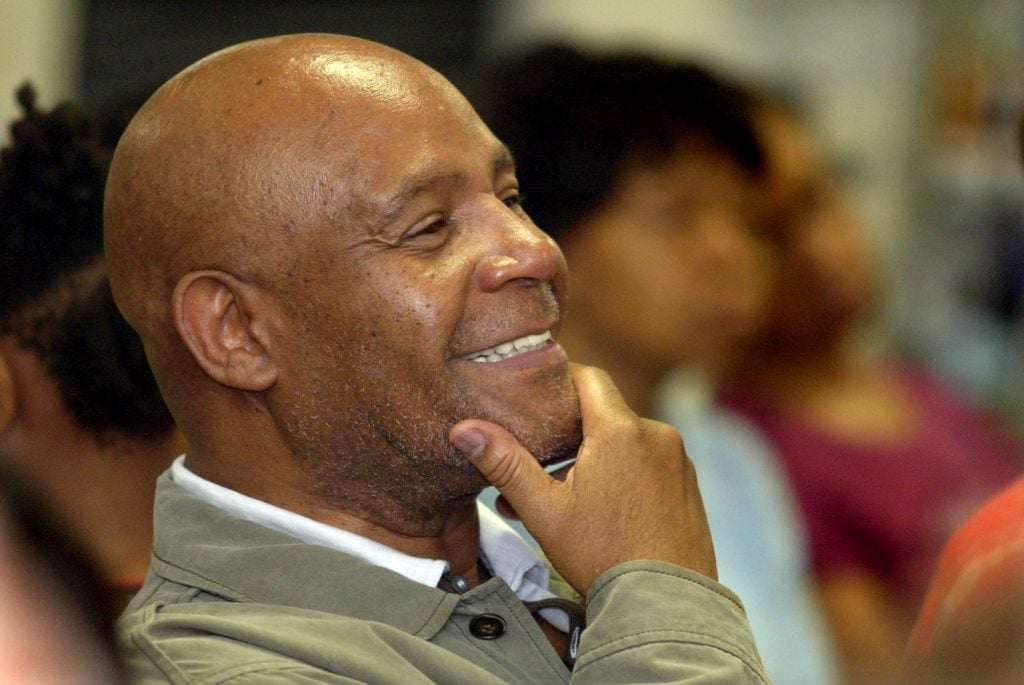
We spoke to the artist about art, protest, and why his work is gaining belated canonization.

Melissa Smith

Emory Douglas is an activist, and always will be. But the 77-year-old artist thinks that the young people protesting across the United States should be allowed to create their own legacy independent of the one established by the Black Panther Party, an organization he was a part of for almost 15 years.
Douglas served as the revolutionary artist and minister of culture for the Panthers, and was in charge of creating images (largely disseminated through its official newspaper) that established a visual record of the party’s platform. Lately, journalists have been reaching out to ask him to comment on today’s protests against police brutality. Knowing how easy it is for movements to get coopted, he’s agreed to talk to some, but after that is “staying out of it,” he says, preferring to allow the protestors to speak for themselves.
Douglas has managed his career as an exhibiting artist with similar discernment, examining each opportunity that comes his way for its social-justice bonafides. The artist and dealer Suzanne Jackson, founder of the influential Gallery 32, was one of the few people who exhibited his work while the Black Panther Party was still active.
It wasn’t until the mid-aughts, he says, that others within the art community began to meaningfully engage with his depictions of police as pigs and of Black mothers tending to their first and second shifts. Decades after he started making art, he was finally gaining broader recognition for the way in which he used images as a tool to stimulate political and social change and for the extent to which the party proved how effectively images can shape public opinion.
In 2006, the artist Sam Durant edited a monograph about Douglas’s influential work, setting in motion a major solo museum show, his first, at the Museum of Contemporary Art in Los Angeles (“Black Panther: The Revolutionary Art of Emory Douglas”), which triggered an inexhaustible churn of interest in the years since.
Douglas has traveled throughout the country and around the world, to museums and politically-engaged organizations and events, using his art to illustrate what’s at the heart of the Panthers’ ethos and practice. He did this not to have them “duplicate what had been done,” Douglas says, “but to be inspired in the context of what they are doing.”
We spoke to Douglas about art, protest, and how museums have changed over the course of his career.
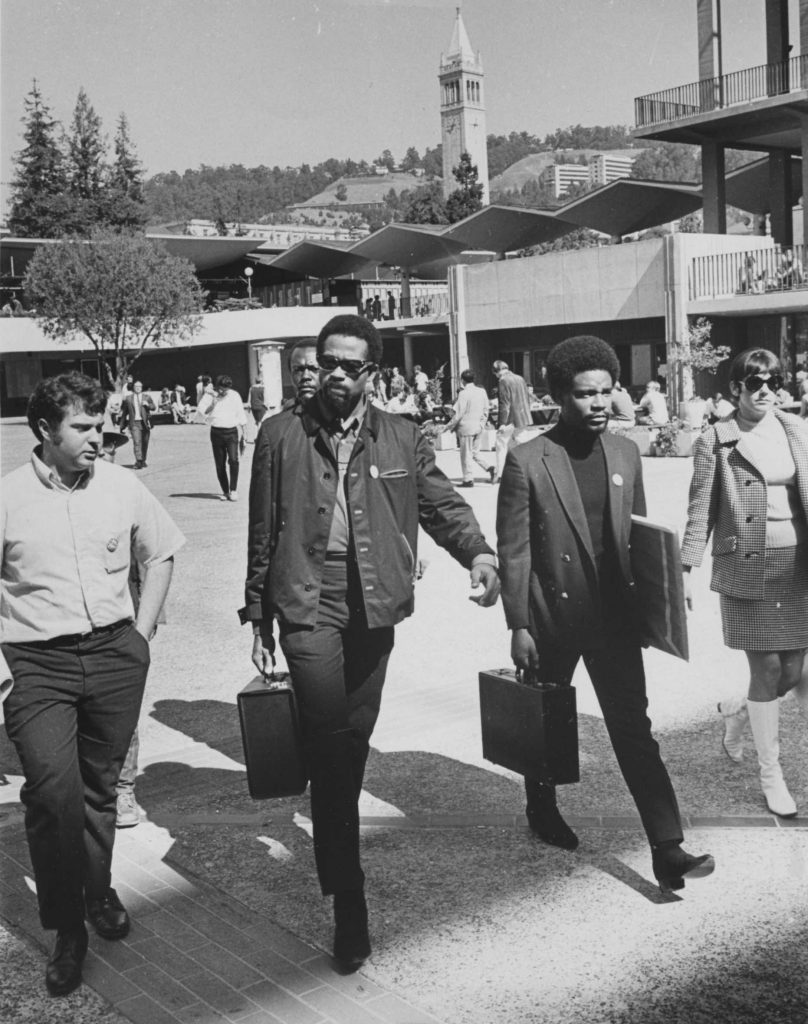
Lawrence Magid, Eldridge Cleaver, and Emory Douglas, Black Panther Party artist in 1968 at UC Berkeley. Digital First Media Group/Oakland Tribune via Getty Images.
The Black Panther organization doesn’t exist anymore. Did it leave behind a blueprint for protestors today?
For those who are aware and conscious, for some of the historical things, they’ve been inspired by [that]. But I think it’s the direct confrontation and contact with the system on a daily basis. That has changed to the point where Brother Floyd’s murder was the spark.
And with COVID-19 at same time, people are beginning to stress over many things. They are seeing how the system really is not what they [thought]. What they were told to believe in is a lie.
There as an article in the New York Times recently on Black politics; about how elected officials today, even African American ones, are not proposing social policies that affect real change. Instead, young leaders and organizers on the ground are. Was it surprising to see that there’s a lack of real leadership among our elected leaders, even African American ones?
Not really. That’s always been the game. They are locked into those institutions. They have to go along with the program. In many ways, they might say things to calm it down or may mean well in what they wanted to do. But they’re so integrated into the corruptness of the system that it doesn’t allow for them to do anything on a broad scale that can be beneficial to the constituency across the board.
I know how crucial it was for you back then to create a visual language for the cause—both in exposing the oppression of African Americans as well as changing the way African Americans depict themselves. What do you think of the role that images play in today’s protests? And how do you think the broad use of social media changes or expands on that?
You guys can reach people almost instantaneously, in real time, because of digital media today. So those dynamics are very powerful. Back in the day, you can have an organization with chapters and branches, like we did across the country. And I was always being interviewed by mainstream publications—otherwise you weren’t able to the message out. The mainstream media needed something to cover, so the civil rights movement and the human rights movements that were taking place were always up front in the news at any given time. In that context, people became highly aware of what was going on. But in today’s world, you can do it 24 hours, seven days a week, 365 days a year. And that’s why you see worldwide solidarity beginning to exist.
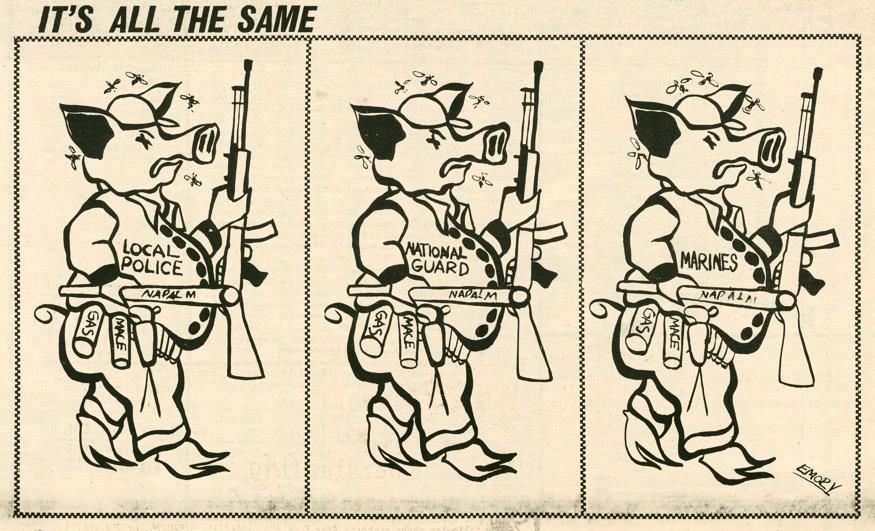
Emory Douglas’s illustration of police officers as pigs for the Black Panther Party. Courtesy Flickr creative commons.
Did you ever think that your depiction of police as pigs would take off as much as it has and become so much a part of our consciousness?
There had always been a psychological response that did transcend the Black Panther Party in the African American community and it became a national and international symbol.
Of course, there had always been political circles where people identified with it [more], but today you got [digital] media now, and people can [easily] pick it up and flash it online. Over the years, when I was working here in San Francisco with the Black press, there was always this awareness and consciousness about that work. It has always been a part of the people’s cultural identity in relationship to how they thought about injustice. The pigs became a psychological symbol of resistance.
When did your work start getting recognition from the art community, and from art institutions? When is the first time someone reached out to you about exhibiting your work?
Gallery 32 in Los Angeles [was the first]. As far as overall interest of galleries, that has come about later on. That came along with more awareness of what was going on in the real world. When Black lives matter to others. And even before that, when you had more liberal and progressive folks who began to work in the museum, and they began to look at and frame it as part of American history.
And I began to communicate and more talk more [around the time] my art book came out.
The book you worked on with Sam Durant in 2006?
Yes. I began to travel to colleges and universities, doing collaborations all over the place. That became the way that many museums got interested in the work.
Plus, you began to have a lot of scholars of color who began to write about the work. All the different films that you begin to see, or documentaries around the Black Panther Party—and the artwork would always be highlighted. It was being talked about and discussed—the visual importance of what was happening during that time. So you have all those dynamics that play into how the images became acceptable in the context of the museum world.
When I did the [show] at MOCA in Los Angeles, it was Sam Durant who had an installation there at that time. [The museum] gave him the option of doing whatever he wanted to do—presentations and talks. And that’s why he tried to contact me—because he said he was inspired by the work. And when I did a talk, it was packed. But you had people who normally don’t come to museums—a lot of social justice and community people. And they saw that as a possibility for a new audience coming to museums. So when [Sam Durant] approached them about having an exhibition, they jumped on it.
They were just underestimating the interest, which isn’t surprising.
Yes. And then I went to New York to the Studio Museum in Harlem and the [New Museum], they were collaborating together. And the same thing there, sold out.
Once I went to Argentina, a [design collective] called Trimarchi [invited me to their art event]. They held it in a huge stadium, like an NBA-sized stadium.
So you had all these young artists, about 5,000 or 6,000 of them. Some of them in the corridor of the outside [with] their art installations, selling artwork.
They said to me that right now, they’re coming to the point where they’re trying to be more conscious of including political artwork into the discussion, so that’s why they invited me. After the presentation, I got such a [good reception], I thought, what was it they found so stimulating? And it occurred to me that they could see in the art the resistance and self-determination and they could apply it to some of the things they were dealing with in their lives, in their countries. So the art became a link of solidarity, transcending borders—continuing on with these young people.
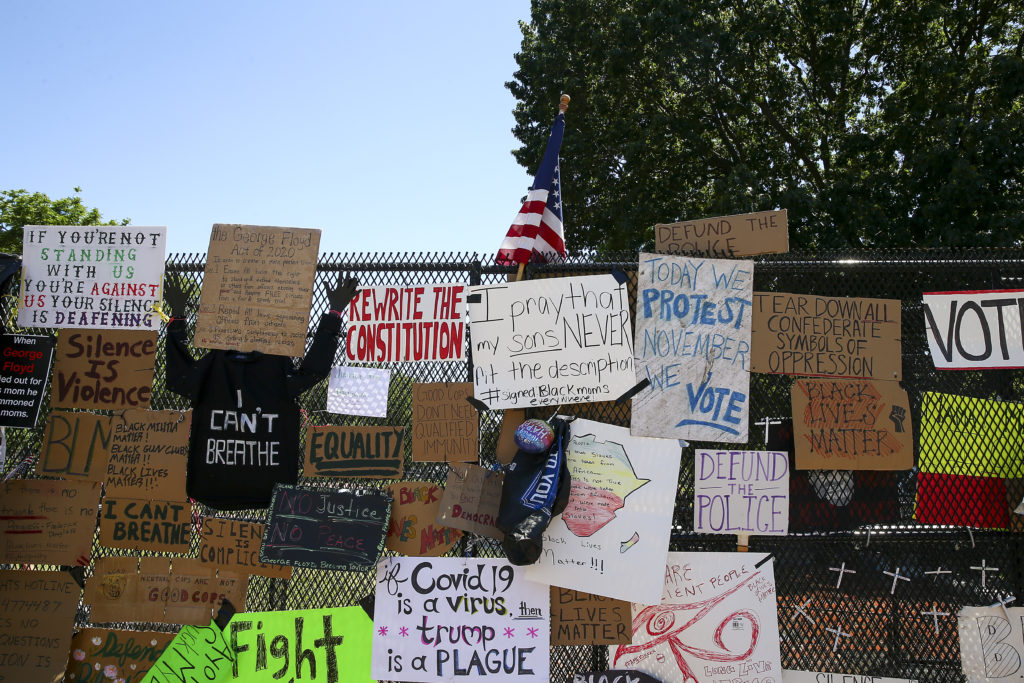
The steel fence at Lafayette Park has become a makeshift memorial at 16th street after “Defund The Police” was painted on the street near the White House on June 08, 2020 in Washington, DC. After days of protests in DC over the death of George Floyd, DC Mayor Muriel Bowser has renamed that section of 16th street “Black Lives Matter Plaza.” Photo by Tasos Katopodis/Getty Images.
Do you think it’s interesting that as more of these clashes are happening, museums are collecting protest images in real time?
Yes, like at the Smithsonian. Again and again, it’s young folks in there who can do it now, who couldn’t do it before. That’s one of the keys. Because there was a time when you would have exhibits—not necessarily radical exhibits—that they would claim were immoral. They were trying to close them down. Now you’ve got [people] coming there, students who graduate from universities who were a part of the movement in some kind of way, or in solidarity [with the movement], or thought of it as free consciousness or free speech. Then they have their kids who they talk about their history to. And then that transmits to what you see today in opening up the museums in many ways.
Do you feel like that interest is going to continue? Especially on the institutional side?
Well, you have so many demands now. And Black and brown artists who are talking about it. And white artists who are opting out of working in museums—and particularly doing stuff in museums where they got all these colonial powers on these boards. All those things are being exposed. That is shifting stuff.
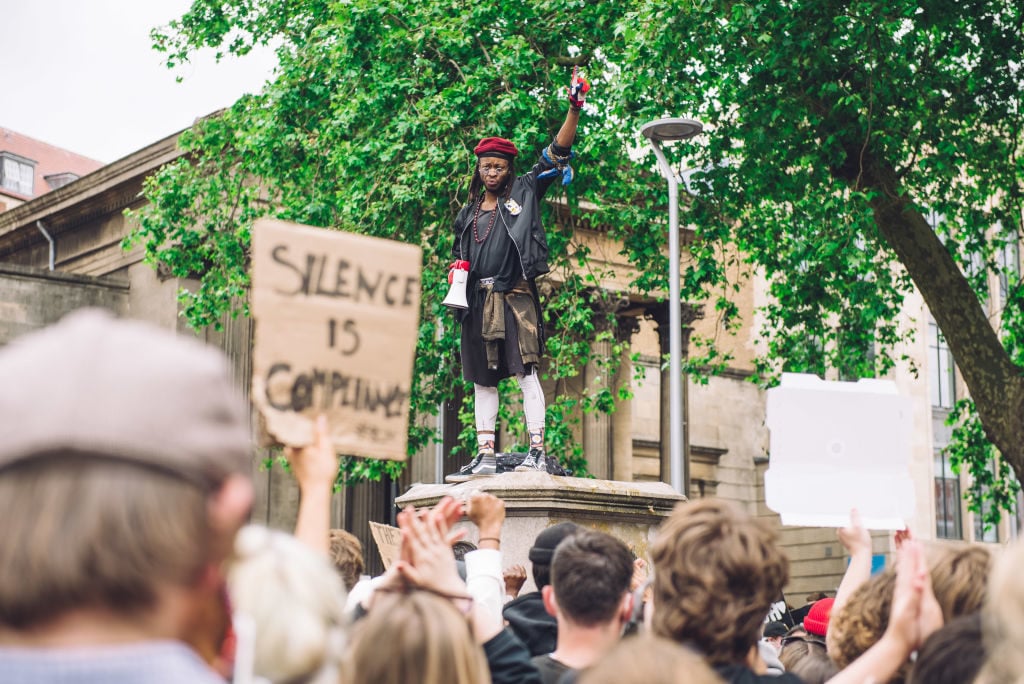
A protester speaks to a crowd from the pedestal that once hosted the statue of Edward Colston. Photo by Giulia Spadafora/NurPhoto via Getty Images.
People are speculating that today’s protest movement is going to change how institutions operate generally with respect to social justice. Do you feel as though this is going to precipitate real change?
It’s a worldwide thing now. They could shove it off before and call it insignificant. But you can’t do that anymore because this is a worldwide protest against bigotry and racism.
So you’re optimistic?
You can be optimistic and, at the same time, the question becomes: has it been ingrained enough to make it happen as it should at this point in time? Or will it be a drawn-out, incremental process?
Well, I certainly hope you still get the proper attention on your work.
It’s more so the fact that 50 years later, the artwork still has relevancy to it. Because we still have some of the same things happening now as happening then. You have young people who see that. When I do a talk, they’ll say, “Well, you could just tweak this and tweak that, and it could be 50 years later.”